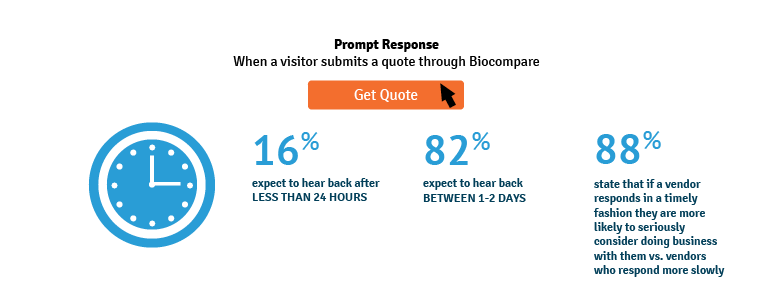Lead generation has taken on a new level of importance during these challenging times. Now more than even leads are a precious and highly coveted asset.
This article provides some lead best practices that we hope will help with conversion and subsequently lead to more sales for your organization!
1. Start by Scoring Leads
Scoring is a way to prioritize leads for proper follow-up. The scoring system you use can be anything that works for your company—as long as both sales and marketing teams agree on the lead scoring criteria. Typical approaches include giving a lead a score 1-5, or Cool-Warm-Hot. Higher scoring leads might be immediately ready for salespeople. Lower scoring leads might belong in marketing’s lead nurturing program.
Weighted attributes that make up a score could be:
- Source of lead. The source of a lead is often a good indicator of its quality. Leads, for example, from Biocompare’s product directory have already narrowed down their selection of which supplier(s) they want to engage with, have clicked on “Get a Quote” or “Request More Information,” completed and submitted a form, and are then delivered to the relevant company. In other words, these leads are sales-ready and should not be bundled with leads generated from demand-gen activities that are higher in the funnel, such as content downloads or webinar leads.
- Information collected on the lead. The more information you have about a lead, the better you can engage with them in a relevant manner and help them along their buying journey. A lead form might include required fields for name, company, product interest area, buying time frame, etc. Careful consideration of what questions are included on lead forms is of utmost importance, as too many questions, especially those about buying intent on specific products, may have the opposite effect!
- Lead activity. Has this lead engaged with your company in the past? Have they downloaded content or attended a webinar or subscribed to an email? If so, they likely get a higher score.
2. Match Lead Source to Stage of Buy Cycle
Which lead is closer to making a buying decision: one that came from a “Request a Quote” submission or one from a white paper download? Obviously, the former lead is on the verge of a decision, while the latter lead is earlier in their buy cycle, perhaps only exploring needs and possibilities.
Matching sales leads to their buy cycle stage can help you score leads more accurately, and moreover, can provide insight on how to respond appropriately. A comprehensive study commissioned by Biocompare, “Dynamics of the Buying Journey: Trends in Adopting R&D Products & Systems,” by Martin Akel & Associates maps the information resources that scientists most rely on during each phase of their buying journey, as is illustrated in the table below.
Although the phases and associated content are not exclusive buckets, they do align with the scientist’s buying journey. The chart below provides hints as to what buying journey phase a lead might be in when you first become aware of them. Use this information to help plan an appropriate response.

3. Time Your Response
You know the proverb “Timing is Everything.” It’s especially true when responding to leads. Biocompare research has shown that companies that followed up with leads generated from our product directory in a timely manner had a 75 percent increase in lead conversion to a sale versus those that did not.
Knowing the type of content a lead has accessed can give you clues to where they are in their buying journey and can help you respond appropriately.
What constitutes a timely manner? Consider that we’re living and working in internet time and that people expect fast responses to their inquiries or they will move on to another company that seems more interested in meeting their needs.

Data: “Dynamics of the Buying Journey: Trends in Adopting R&D Products & Systems - 2019" Conducted By: Martin Akel & Associates
Score leads, match content accessed to the buying cycle, and respond quickly and appropriately—these three key strategies can help you achieve your customer acquisition goals faster and more effectively.